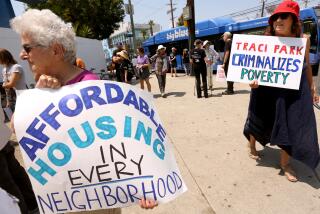Editorial: Can a new collaboration make headway on solving homelessness? Give it a shot

When a group of enterprising community leaders formed the Committee for Greater LA last year to look at how to make a post-pandemic Los Angeles less racist and more equitable, it was only logical that one of the topics would be the poorest, most marginalized group in the region: homeless people. Black people, in fact, make up 9% of the county population but roughly 40% of its homeless population.
The committee’s latest report tackles this issue and proposes a plan. No, it doesn’t solve homelessness. (If only.) But it does lay out a road map for how elected officials from the city and county could reach a consensus on goals and hold themselves accountable for attaining them. Sounds like a long shot, but city and county leaders should try to make it work.
The committee identified the underlying problems that make homelessness so complicated, including racial discrimination, economic inequity, lack of affordable housing and insufficient reentry services for people leaving jail or a mental health facility. But rather than propose solutions, the committee enlisted the help of Raphael Sonenshein, a governance expert who has spent decades looking at the undercarriage of governments — particularly in the Los Angeles region — and trying to figure out how to make them run better.
Sonenshein suggests creating something he calls the Center (and let’s say right here that it needs a less science fiction-y title) featuring a chief executive and two boards: a governing board made up of the mayor of Los Angeles, the chair of the county Board of Supervisors and other state and local leaders; and an oversight board of experts and stakeholders, including service providers, academics, business leaders and people who have been homeless. Together, the boards would come up with specific strategies — for example, how to handle encampments — and sell them to the City Council, county supervisors and the community.
Sonenshein insists this is not like grafting another layer of government on top of existing local government. Instead, he contends, it’s a way for local leaders to collaborate more efficiently and successfully, in part by agreeing on how to define success and measure their progress toward it.
Maybe. They’re certainly not collaborating well now. The 15 City Council members are handling homelessness in their districts individually, as they see fit. There is no overall strategy aside from responding to pressure from U.S. District Judge David O. Carter to shelter homeless people near freeways.
This approach could work if the governing board sets overarching goals — such as reducing homelessness by half in the next five years and providing a specific number of permanent housing units by a certain deadline. Then it would have to hold itself responsible for accomplishing them. That will require the Center’s leaders, most notably the mayor and the chair of the board of supervisors, to get City Council members and the other supervisors to support the same goals and stand up to whatever opposition arises in the community.
Done right, the Center could yield more focused leadership, collaboration and accountability. Heaven knows this crisis needs all three.
More to Read
A cure for the common opinion
Get thought-provoking perspectives with our weekly newsletter.
You may occasionally receive promotional content from the Los Angeles Times.










